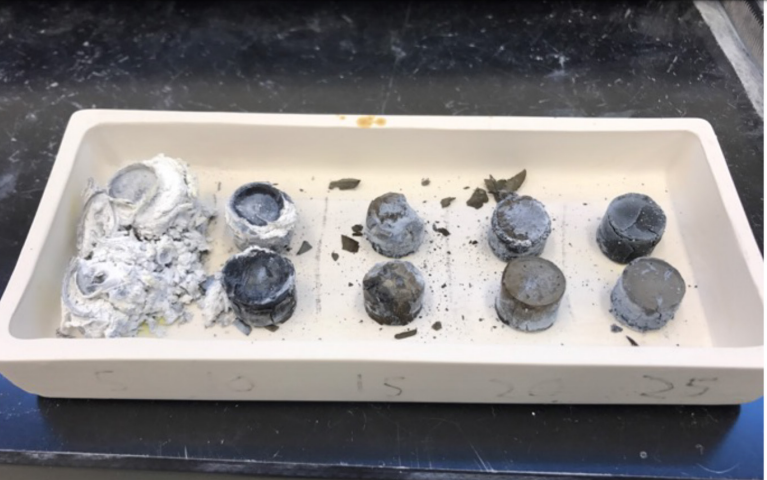Aluminum-Tin Ink May Be Used for 3D Printing Replacement Parts on the ISS
Authors Z.S. Courtright and C.W. Hill of NASA’s Marshall Space Flight Center explore the uses of a very specific metallic ink in ‘Optimization of Aluminum-Tin Ink Composition and Sintering in Atmospheric Conditions.’ For this research project, the scientists focus on developing an ink that is able to sinter, free of the vacuum of inert gases.
 In studying inks with composition that may have promise, the authors use a multi-material 3D printer on site at NASA Marshall Space Flight Center (MSFC). Aluminum-tin ink will be used on the International Space Station if it turns out to be viable for uses such as fabricating replacement parts to perform maintenance in space.
In studying inks with composition that may have promise, the authors use a multi-material 3D printer on site at NASA Marshall Space Flight Center (MSFC). Aluminum-tin ink will be used on the International Space Station if it turns out to be viable for uses such as fabricating replacement parts to perform maintenance in space.
“Along with its zero-gravity advantages, this ink may also have applications on Earth because it may be extruded on a substrate with precise ceramic tips in a 3D printing process,” state the authors. “This would allow the fabrication of precise, complex shapes and may generate a much faster and more efficient printing process as compared with traditional powder bed additive manufacturing processes.”
Aluminum ink formulations were measured with variances due to flux percentages, as they began with lower percentages and then slowly increased the flux percentage. The ink was then hand mixed in a two- to three-hour process resulting with the powder in its initial solution. Samples were created and then sintered in a tube furnace with two different methods:
- Using a 600 °C furnace temperature
- Used a 400 °C temperature
The 600 °C sintering cycle resulted in brittle samples, leaving the authors to reduce it to 400 °C. Furnace sintering ensued for 18 hours, and then samples were dried. Many of the samples disintegrated during density measurements. Ink samples were applied to a ceramic substrate in thin layers, on both 14 and 15 percent flux inks as they used heat-resistant tape on the substrate and then covered it with a layer of ink using a spatula. Samples created at 15 percent flux showed the most consolidation, while those at 5 percent ‘charred completely.’

Ink samples sintered at 600 °C for 18 hours with flux percentages of 5%, 10%, 15%, 20%, and 25% in order–from left to right (two samples at each compostion).
Every layer was sintered before the next was added. The authors state that while layer thickness and overall structure were not uniform, the layers did stick together.
“Future experimentation must be done using the nScrypt 3D printer located at MSFC in order to validate this ink composition for additive manufacturing uses. Initial printing trials on the nScrypt printer indicated that this material will print effectively with the 3D direct-write deposition process,” state the researchers.
“Samples of 13% flux bubbled the least of all samples when submerged in deionized water, indicating a more complete reaction of the flux during the sintering process. Although these samples were much more consolidated and exhibited a more metallic surface finish and consistent density, they still had very weak internal properties,” concluded the authors. “This study has helped to pinpoint a narrow flux range between 13% and 16% and a sintering cycle around 400 °C. The ideal flux percentage was determined to be 15% due to consistent density, ability to withstand the experimental procedure, and because that composition exhibited the most homogeneous metallic exterior with the least internal cracking.
“The material must be tested for desired properties, such as density, electrical conductivity, and hardness. It must also be tested for material properties and consolidation over a range of different thicknesses in order to determine the window of acceptable deposition thicknesses.”
NASA scientists have been involved in all aspects of 3D printing and AM processes, to include recent bioprinting ventures targeting breakthroughs in cancer research, new materials, and studies focused on microbial risk.

Samples sintered at 400 °C for 18 hours and then submerged in deionized water prior to density measurements: (a) 10% flux and (b) 15% flux.
Subscribe to Our Email Newsletter
Stay up-to-date on all the latest news from the 3D printing industry and receive information and offers from third party vendors.
Print Services
You May Also Like
New Business: Temporary, Migratory, & Modular 3D Printed Architecture
If we look at potentially emerging 3D printing businesses, then architecture has not been fully explored. Yes, there is a lot of house 3D printing going on worldwide. From deployable...
3D Printing News Briefs, April 19, 2025: Material Extrusion Standard, Metal Powder, & More
In today’s 3D Printing News Briefs, we’re covering a proposed standard for material extrusion, before moving on to business and metal powder. We’ll end with a commercial store’s robotic 3D...
Japan Unveils World’s First 3D Printed Train Station
Japan is now home to what we believe is the world’s first train station built with 3D printing technology. Located in Arida City, just south of Osaka, the new Hatsushima...
restor3d Raises $38M to Expand 3D Printed Orthopedic Implants
Backed by $38 million in new funding, restor3d is pushing ahead with the launch of four personalized implant lines, set to roll out in 2025 and 2026. This latest venture...


























